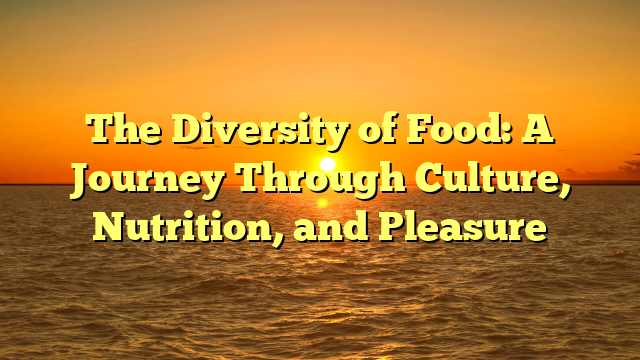
Have you ever wondered why some foods taste amazing while others make you cringe? The way we experience food is not just about the ingredients—it’s a complex process involving our senses, brain, and even emotions. Taste is influenced by sight, smell, texture, temperature, and even sound. Scientists and chefs alike study these elements to create the perfect balance of flavors.
In this article, we’ll explore how our senses work together to create taste, the role of our brain in flavor perception, and why certain foods appeal to us more than others.
1. The Five Basic Tastes
Our tongue is covered in thousands of taste buds, each detecting one or more of the five basic tastes:
👅 Sweet 👅 Salty 👅 Sour 👅 Bitter 👅 Umami – A savory, meaty taste from foods like mushrooms, cheese, and soy sauce.
Scientists believe there may be other tastes, such as fatty, starchy, and metallic, but these are still being researched.
2. How Our Senses Influence Taste
Taste is not just about the tongue—it’s a full-body experience involving multiple senses:
👃 Smell: The Key to Flavor
Did you know that up to 80% of what we taste comes from smell? When you eat, aromas travel from your mouth to your nose, helping you detect flavors. That’s why food tastes bland when you have a cold!
👀 Sight: We Eat with Our Eyes
The color and presentation of food affect our perception of taste. For example, people associate red and yellow with sweetness (think strawberries and mangoes), while green and brown foods might seem more bitter or earthy.
👂 Sound: The Crunch Factor
The sound of food—like the crisp crunch of chips or the fizz of soda—affects our enjoyment. Studies show that people prefer crunchier foods because they seem fresher.
✋ Texture & Mouthfeel
The way food feels in your mouth (creamy, crispy, chewy) also affects how you perceive its flavor. A perfect example is chocolate—it melts in your mouth smoothly, enhancing its sweetness.
🌡️ Temperature & Spiciness
Temperature changes flavor. Ice cream tastes less sweet when frozen, and coffee tastes more bitter when cold. Spicy foods activate pain receptors, creating a burning sensation rather than a traditional “taste.”
3. Why Do Some People Love Certain Foods While Others Hate Them?
Ever wondered why bayar4d love cilantro while others think it tastes like soap? It’s because of genetics! Our DNA influences how we perceive flavors. Some people have more taste receptors, making bitter foods like Brussels sprouts or black coffee taste too strong.
Other factors that shape food preferences include:
👶 Childhood Exposure 🌍 Cultural Influence 🧠 Psychology & Memory – Positive or negative food experiences affect how we feel about certain flavors.
4. The Role of the Brain in Taste Perception
Your brain plays a huge role in how you experience food. When you eat, your brain processes signals from your tongue, nose, and even past experiences to create what you perceive as taste.
🧠 The Reward System 🧠 Expectation vs. Reality 🧠 Placebo Effect – If you believe an expensive wine tastes better, your brain will make it seem more enjoyable—even if it’s actually the same as a cheaper wine!
5. How Chefs & Food Scientists Use This Knowledge
Understanding taste perception allows chefs and food scientists to create more enjoyable foods. Some techniques include:
🍽️ Food Pairing 🍽️ Plating & Presentation 🍽️ Texture Manipulation 🍽️ Umami Boosting – Chefs use ingredients like soy sauce, mushrooms, and Parmesan to intensify savory flavors.
6. The Future of Taste Science
Scientists are working on exciting innovations in taste perception:
🔬 Artificial Taste Sensors 🔬 Taste-Altering Compounds 🔬 Personalized Nutrition – Custom diets based on individual taste genetics.
As we learn more about taste, food will continue to evolve, becoming healthier, more enjoyable, and even tailored to our DNA!
7. Conclusion: A Deeper Appreciation for Flavor
Taste is far more complex than just sweet or salty—it’s a multisensory experience shaped by sight, smell, sound, and psychology. Whether you’re enjoying a rich chocolate dessert or a spicy curry, your brain and body work together to create the perfect flavor experience.
So next time you eat, take a moment to appreciate how all your senses contribute to the deliciousness of your meal! 🍽️😋




